Table of Contents
A SERP is a page that appears when you input a search term into a search engine like Google or Bing. Page one is a battleground for search engine optimization (SEO), a technique that involves improving websites to make them more visible to search engine users. And changes in position can mean millions in revenue gained or lost.
Understanding Google SERPs is critical to a successful digital marketing strategy. SERPs give you insight into what content search engine algorithms rank, what your competitors are doing, and how you can compete effectively.
What is a SERP?
A SERP stands for “search engine results page.” It’s a list of ranked Google search results that search engines believe answers a search query. This SERP for the search term “What is a SERP” is what Google’s algorithm believes is the best answer to the question based on over 200 ranking factors.
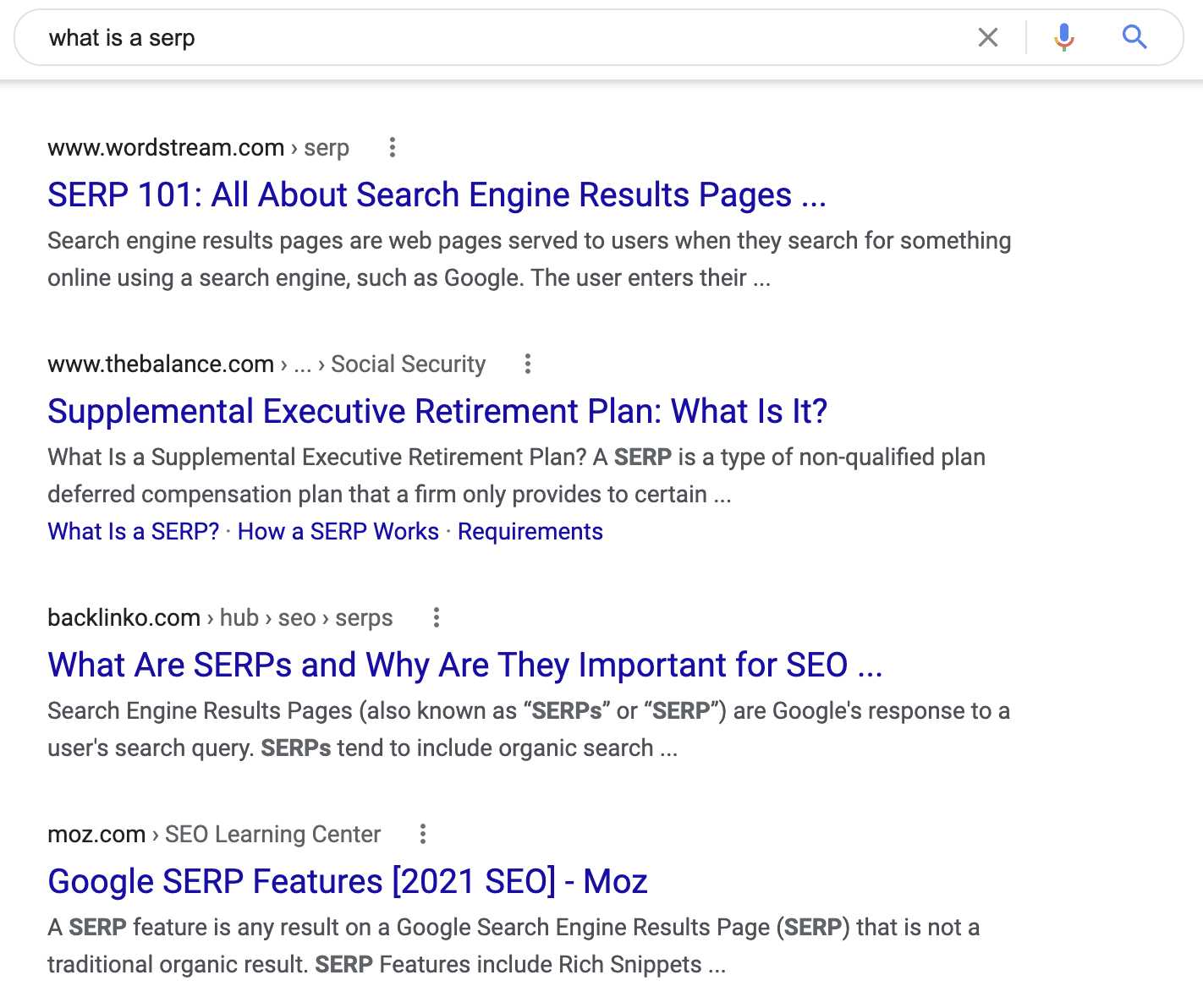
Why SERPs are important for SEO
SERPs matter for SEO because they’re the result of your SEO efforts. When you do everything right in terms of SEO, you show up as a search listing, ideally on the first page, where most Google searchers click results (most searchers do not move past Google’s first search engine results page for a given query).
You need to understand how SERPs work so that you can create content that is more likely to show up on a SERP. The closer your listing appears to the top of Google’s first SERP for a given term, the more traffic you are likely to earn. And more traffic means more visitors to your website, which translates to more opportunities to generate revenue.
Essentially, if you understand how a SERP works and how to rank on a SERP, you have a better chance of getting a return on your SEO investment.
SERPs are the product of search engines. Search engines work by using algorithms to decide what content to serve to a searcher when they input a search query into the engine. They do this by trying, as much as possible, to determine the intent of the searcher. What is the searcher looking for when they input a keyword phrase?
This is one of the top ranking factors for Google and other search engines — search intent— and SERPs can help us gauge what search intent might be for a keyword phrase.
For example, in the image, the search query, “cheap iPhones for sale unlocked” returns a number of product ads and product pages.
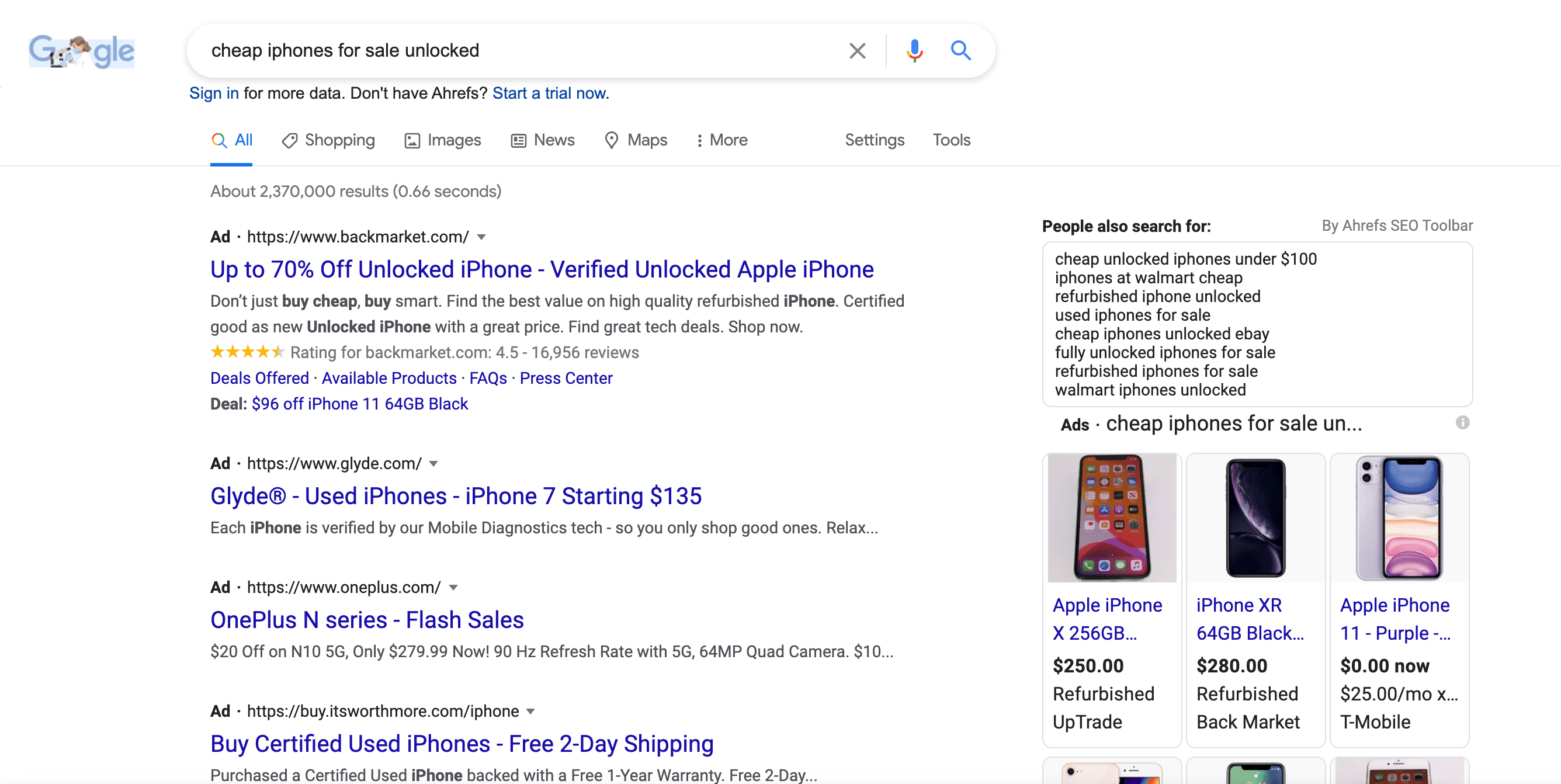
It also returns three stores where iPhones can be purchased near the searcher.
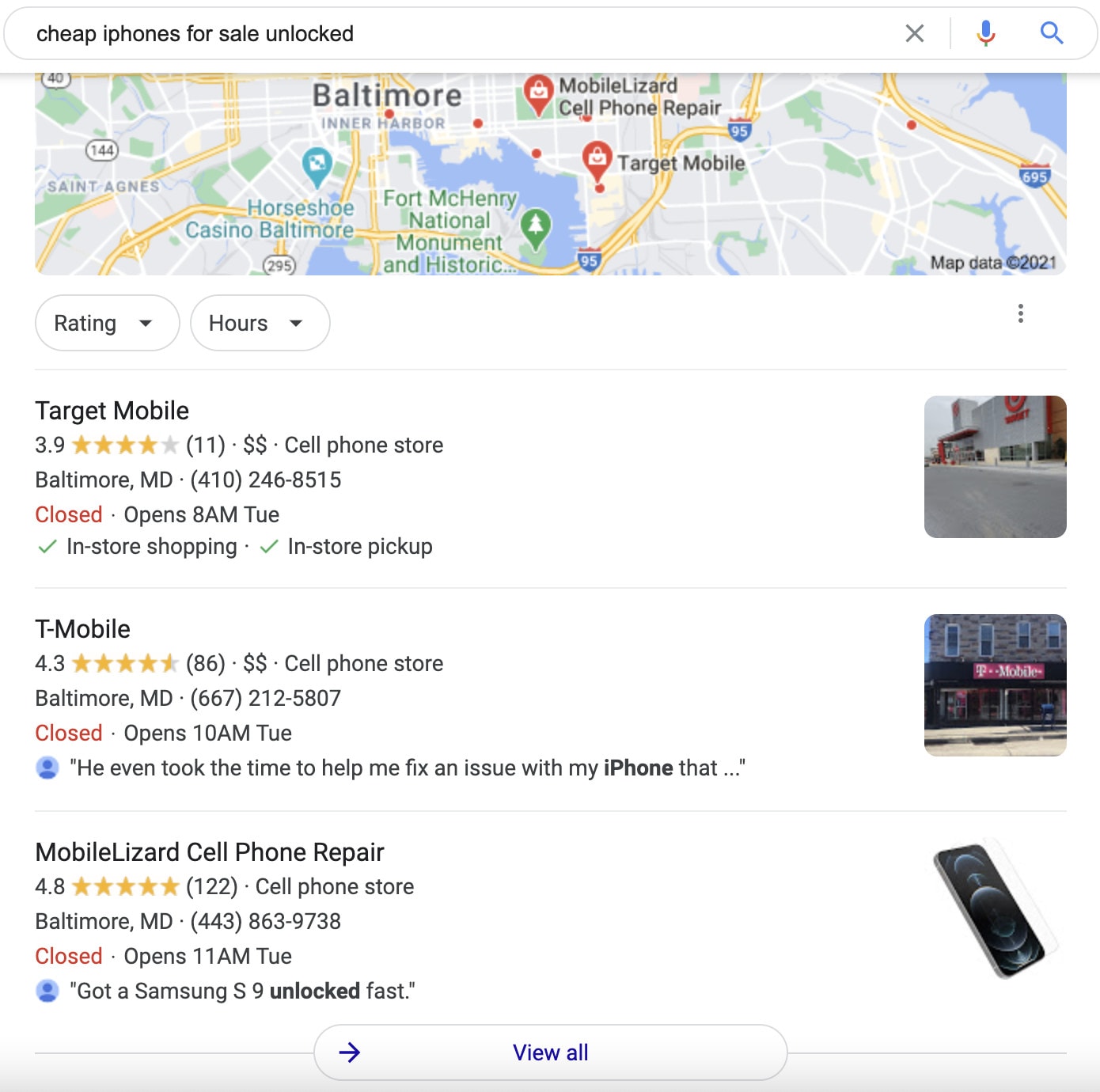
If you look at the top organic results, you’ll see articles about iPhone deals.
With this knowledge, you can understand the search intent behind this keyword phrase—Google believes that the searcher is looking to make a purchase of a product (iPhones).
Your job is to figure out what kind of content you can create to match up with this search query. If you sell iPhones, this might be a product page. If you are an affiliate marketer and make money when a reader clicks a link on your page, then a listicle about the best cheap iPhones deals in 2021 (as you can see on the SERP) might be the best kind of content to create.
It all depends on how you generate revenue. You need to create content that matches search intent while still generating revenue for you in some way.
While search intent is growing in importance as a ranking factor, there are others:
- Backlinks—links from another website to your website.
- Freshness—how recently the content has been written/updated.
- Topical authority—how often you create content about a specific topic.
- Content depth—how in-depth your content is about its topic.
- Page speed—how quickly your website loads.
- Security—if you use HTTPS.
- Mobile-friendliness—if your website is responsive, which means it’s designed to show correctly on all screen sizes, especially mobile devices.
These are only a few of the ranking factors that Google considers. There are over 200 known ranking factors.
Potential customers make 3.5 billion searches on Google each day. Many of those searches are linked directly to purchases. Higher rankings on SERPs are correlated to more traffic, and more traffic means more chances to generate revenue.
The anatomy of a SERP
SERP features include many different types of content. The image below shows the first page of organic search results, which are the top results that are not ads. These organic listings include content from some of the top SEO content producers, like Moz and WordStream.

A result is made up of a meta title and a meta description. A meta title, which replaces the title tag on the content itself and only shows up on a SERP, is a title written specifically for a SERP. It usually includes a keyword phrase, and it should be between 55 and 60 characters long.
A meta description should be a maximum of 165 characters and should include the keyword phrase of your content along with a call-to-action.
SERPs also contain ads—paid results, known as pay-per-click (PPC) results—which generally show up at the top of the SERP, as you can see in this image:

Another type of content that shows up in SERPs is a featured snippet (also called the answer box). Featured snippets are pieces of content pulled from one of the results on a SERP that give the searcher information in a format that the search engine believes is relevant to the search query.
Featured snippets require you to implement schema markup on your website and can increase click-through rates (CTR) by 667%.
In this example, the featured snippet shows up below the ad:
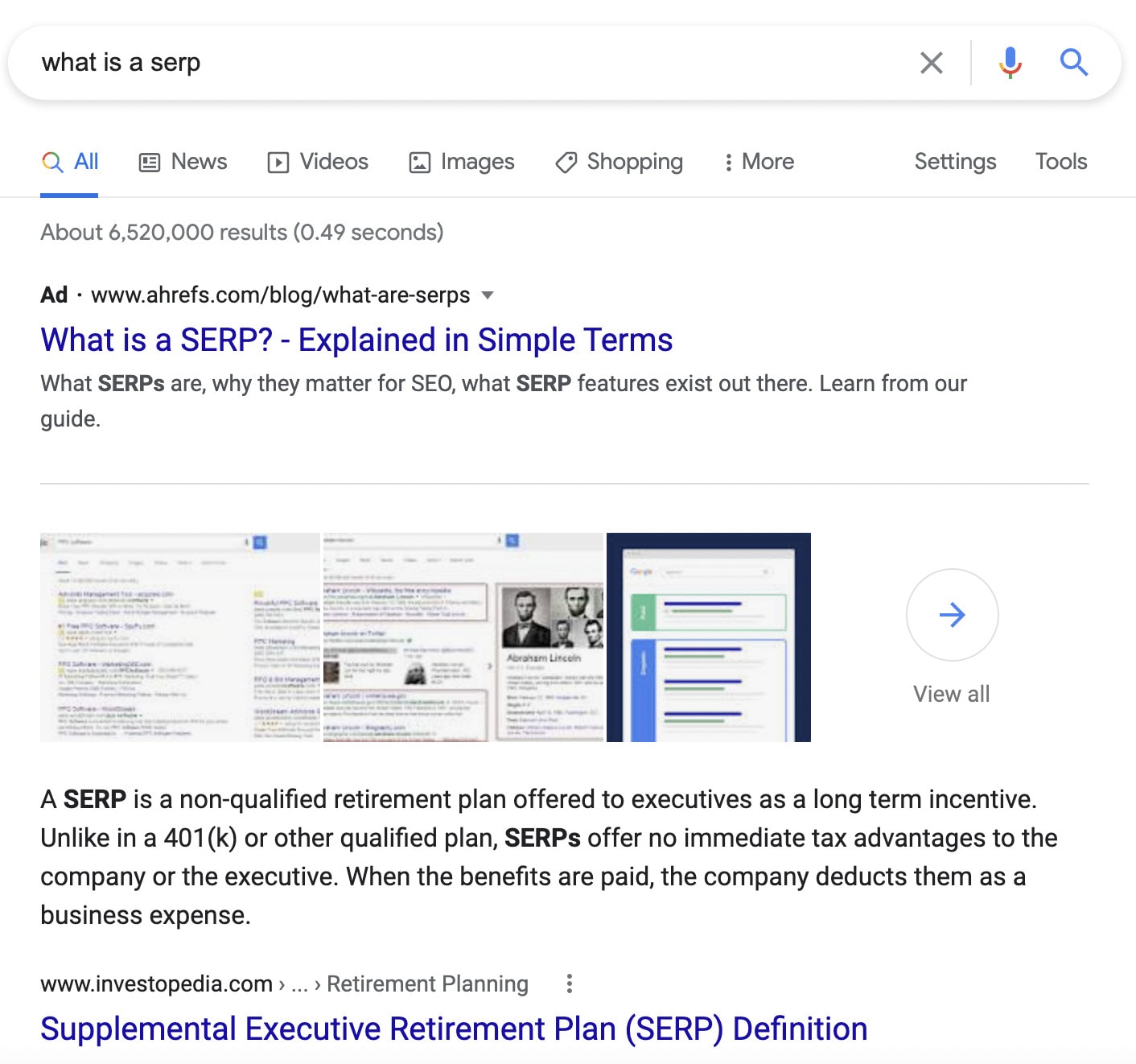 You can get a featured snippet position if your content matches what the SERP is returning for the featured snippet, and if your result is already ranking on page one for the keyword phrase. In this case, the featured snippet is a definition, so if you want to get the featured snippet position, you’ll need to include a definition in your content.
You can get a featured snippet position if your content matches what the SERP is returning for the featured snippet, and if your result is already ranking on page one for the keyword phrase. In this case, the featured snippet is a definition, so if you want to get the featured snippet position, you’ll need to include a definition in your content.
This example provides another insight: Search engine algorithms can have trouble figuring out what content to serve to a searcher at times. In this case, the featured snippet provides a definition of a SERP of a different kind — a type of retirement plan.
Google search provided results for two potential meanings because of this uncertainty. You can also see that the organic search portion of the SERP has two different types of results—a definition for a search engine results page and a definition for a type of retirement plan.
Another portion of the SERP can be helpful for identifying keyword opportunities—the “people also ask” (PAA) section, which can be thought of as an FAQ for Google: This section of related questions again includes answers for both search engine results pages and the retirement plan acronym.
This section of related questions again includes answers for both search engine results pages and the retirement plan acronym.
One insight you can draw from this is that, if you’re a marketing company writing about SERPs as they relate to SEO more, more must be added to the search query to provide a result that the searcher is looking for. For example, the first result in “people also ask” is “what is a SERP in SEO.”
If you click that result, there is no ambiguity—a clear result for a search engine results page shows up.

This is one reason it’s so important to study SERPs. Someone creating content for an SEO firm or a content marketing firm might be tempted to target the keyword phrase, “what is a SERP,” but they might not realize that there is another type of SERP—the retirement plan.
By studying the search engine results page for this query, they can see that this question, “what is a SERP in SEO,” might be a better phrase to target because it clarifies the search and ensures it’s targeting the right searchers.
The same can be said for a retirement plan firm. It won’t do them any good to write content that gets confused with search engine results pages. Instead, they may want to target some of the other keyword phrases that show up in the “people also ask” section, like “what is a SERP plan.”
Depending on what keywords show up in a user’s search, there are other types of content that can show up on a SERP.
For example, if a person or place is searched for, you may get a knowledge graph in the right-hand column, like this:
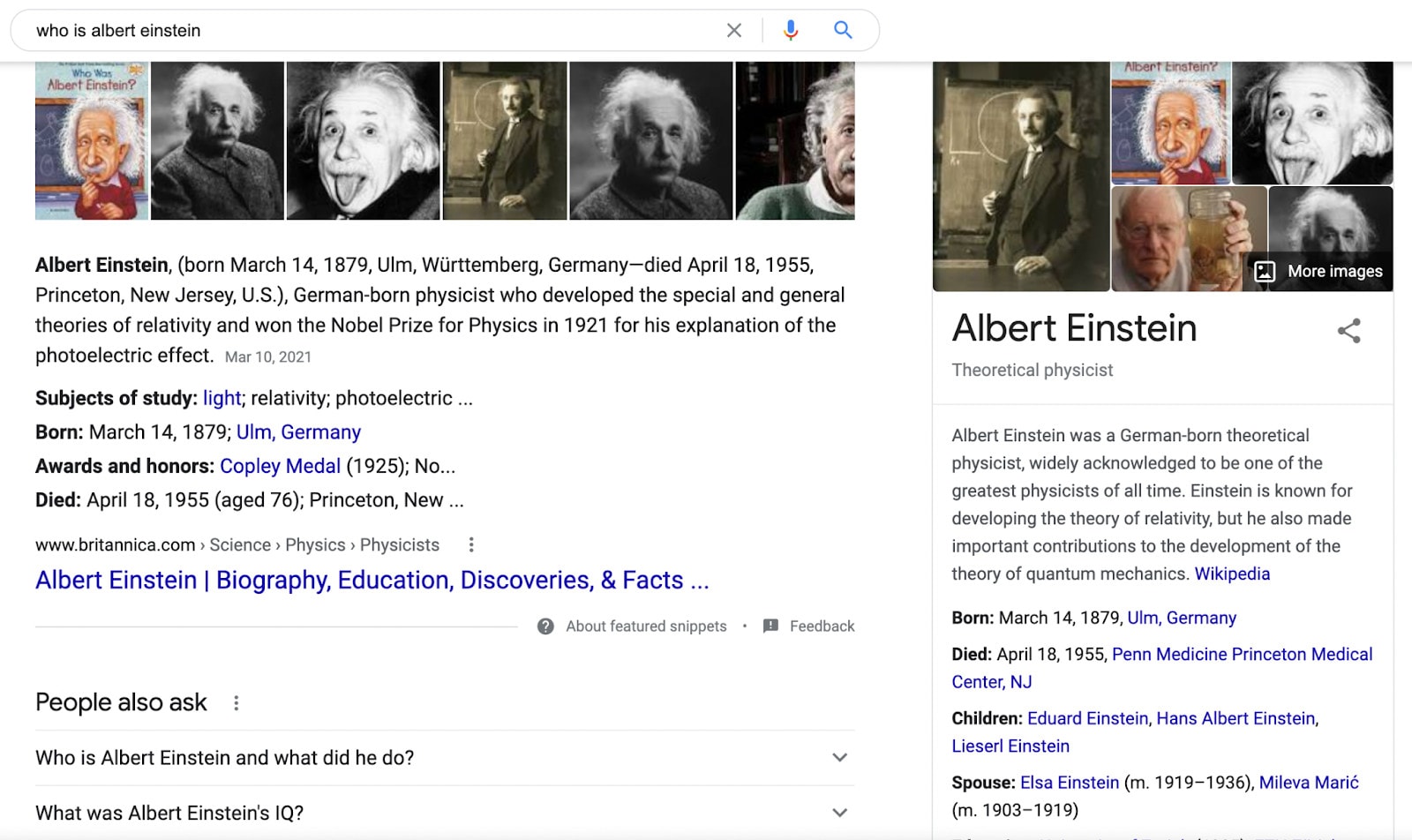
Knowledge panels are often pulled from Wikipedia, though they can come from other web pages.
This image also shows another type of result—the thumbnail images that show up in a carousel above the featured snippet that’s pulled from Britannica.com.
Ads (which are created in Google Ads, formerly called Google Adwords) can also show up in the right hand column of shopping results, as you can see for the search query, “iPhones for sale.”
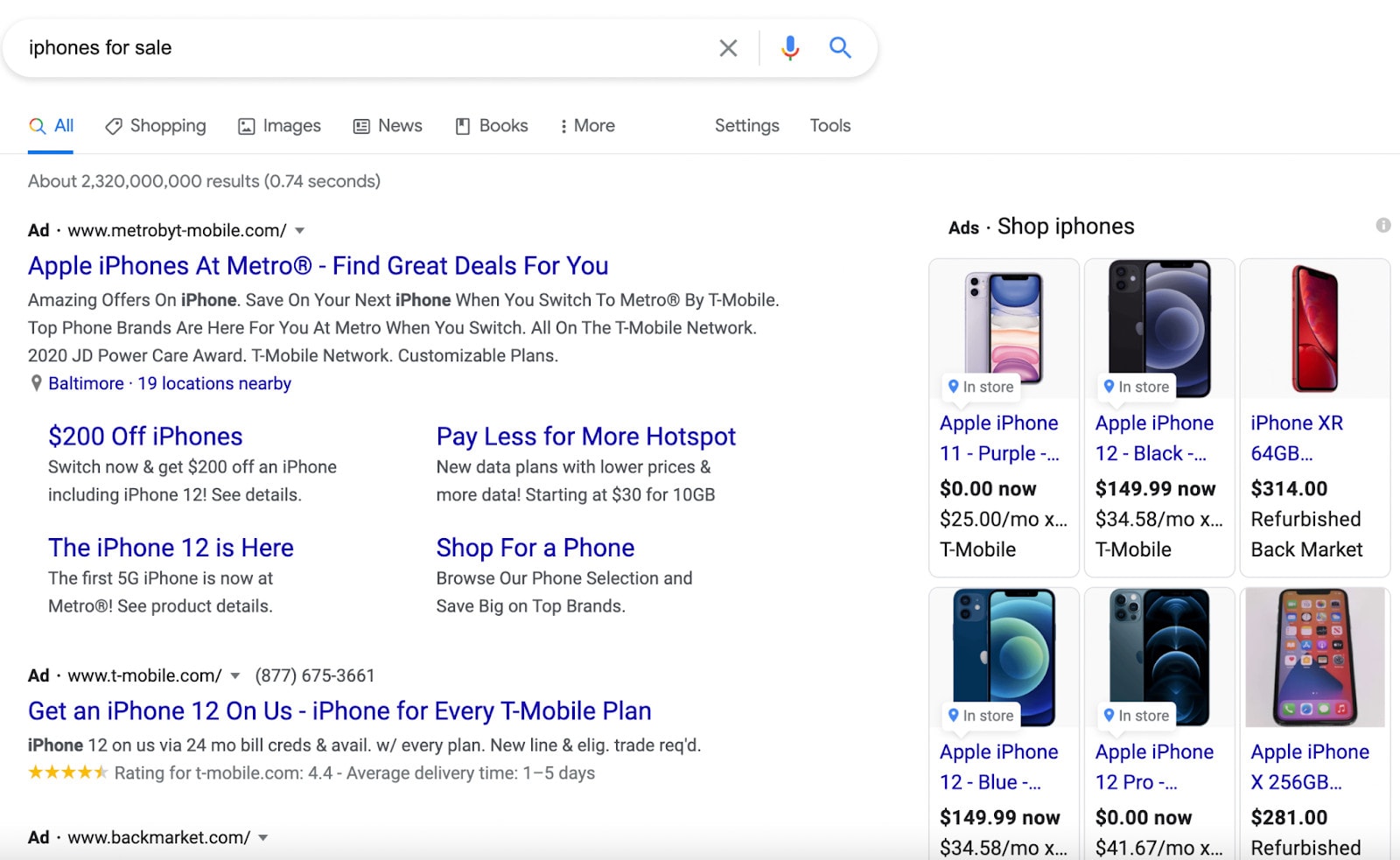
The organic results for this query also show a carousel with product prices, though rather than paid ads, these results are pulled from articles, like “Best phones in 2021.”
Further down the page, the SERP shows nearby retailers that sell iPhones. This section is called the local snack pack and is a huge driver of traffic for local businesses. In fact, 44% of searchers click results in local packs:
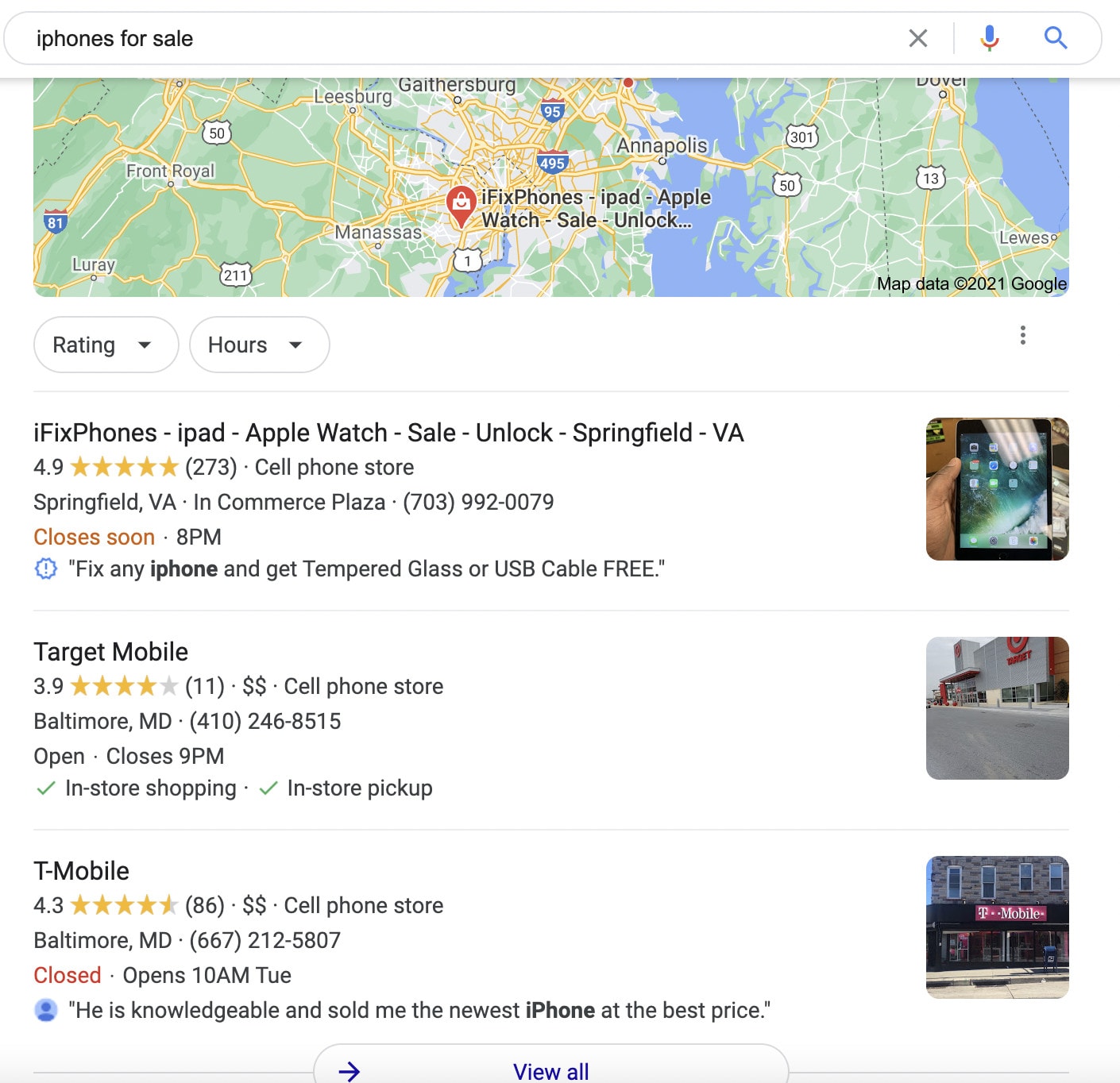
Ranking in the local pack depends on a few different factors, like having your Google My Business account set up and getting a lot of 5-star ratings on Google and other search engines (like Yelp).
The local pack is based on your physical location—in this case, Baltimore, MD. The result at the top of the page is the one with the highest number of 5-star ratings.
Another section of a SERP that can have a lot of value for SEOs is the related searches section. This appears at the bottom of the SERP:
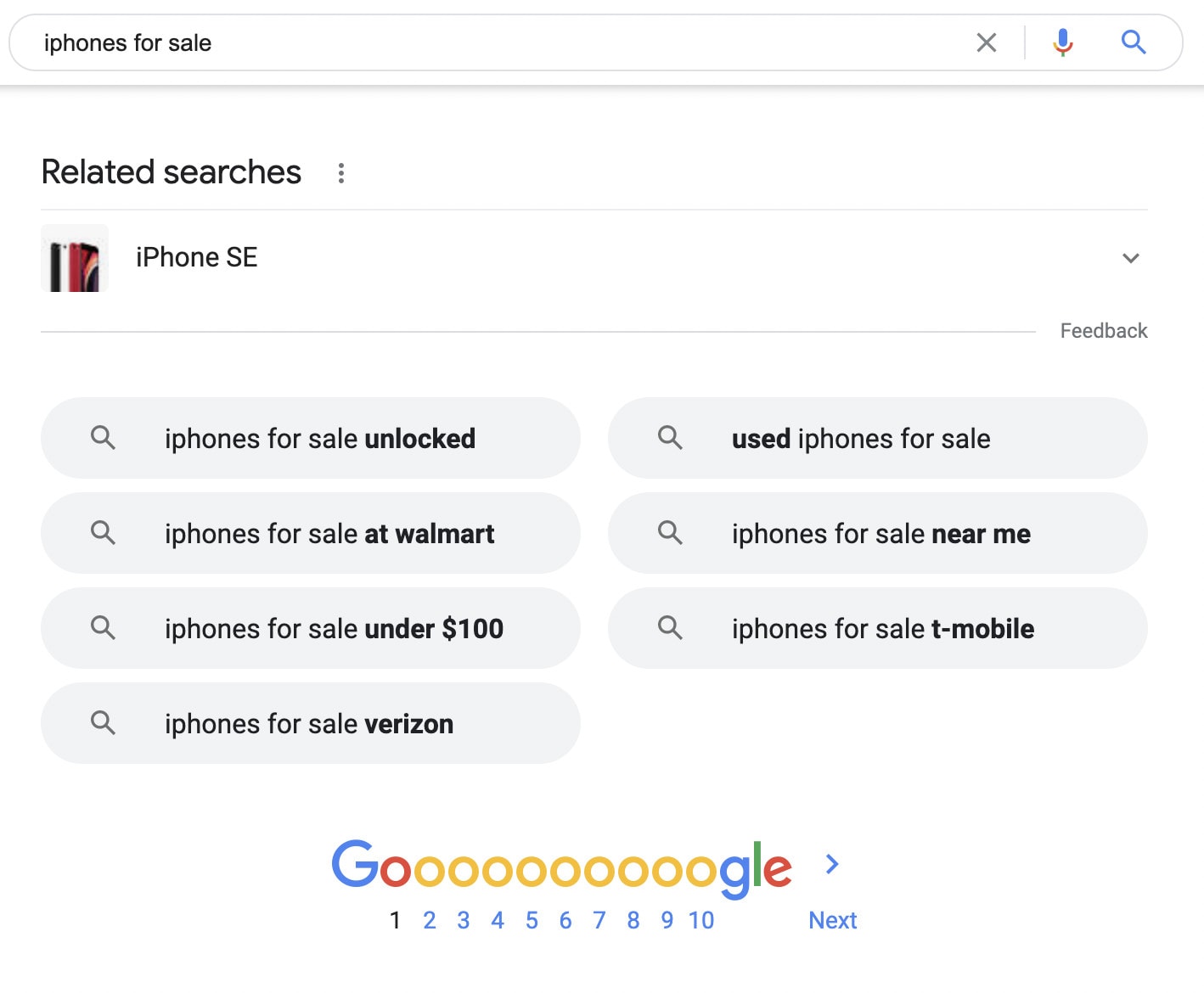
This portion of the SERP is valuable because it can supplement your keyword research. It gives you a number of potential search queries that you can use as a jumping-off point for new pieces of content. For example, you could write an article about, “The best iPhones for sale for under $100 in 2021.”
Another portion of a SERP is the knowledge card. This often results in what’s called a “zero-click” result, where searchers get all the information they need about their search query without ever clicking a result.
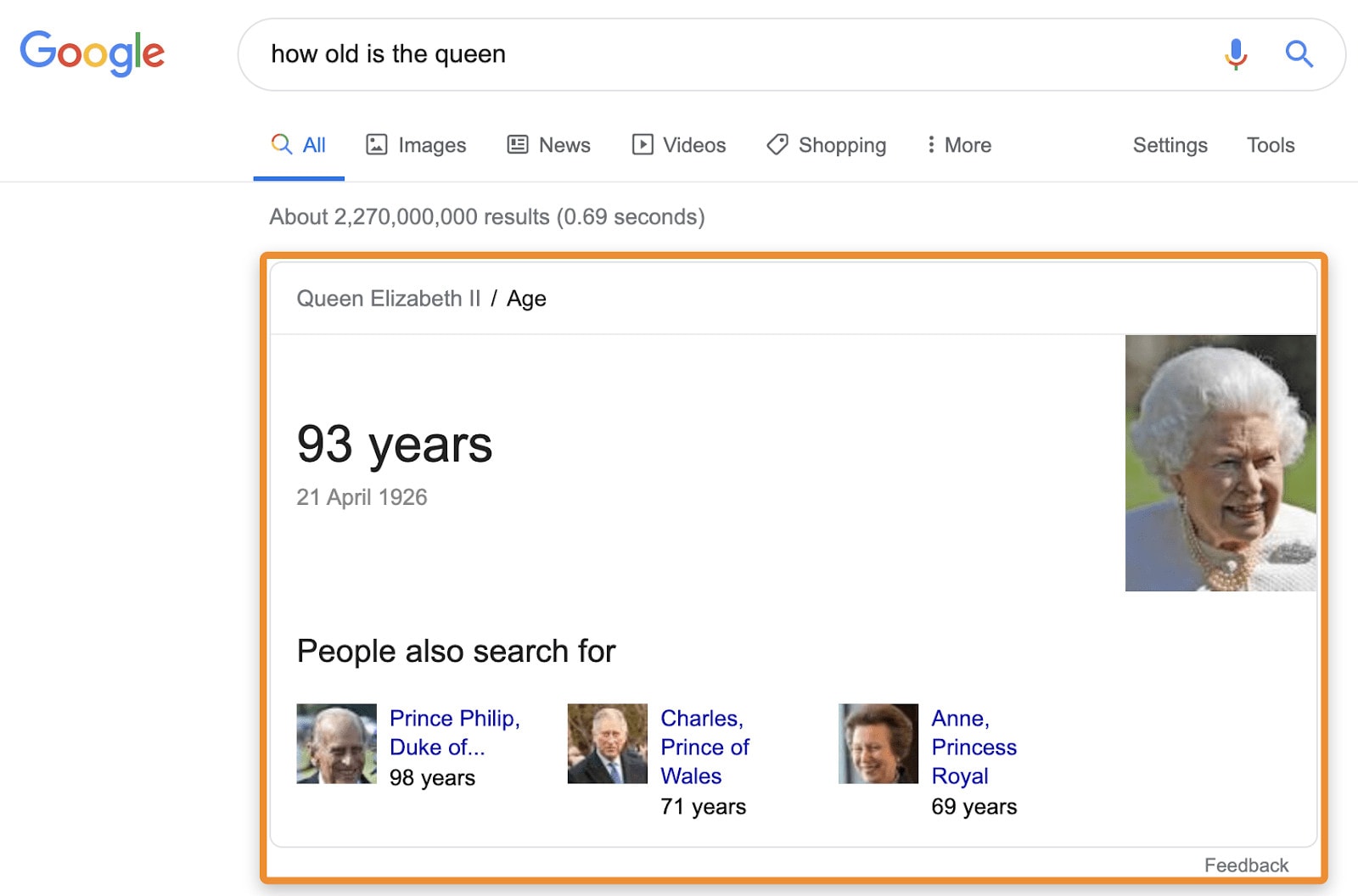
Google does this to provide a better user experience. For this specific query, there’s no need for the searcher to click on the results—the result shows up right at the top of the page. Google will return knowledge cards for simple queries that it can answer definitively.
Another type of content that can show up, depending on the search query, is imagery. In this case, for the query, “images of dogs,” the results show an image pack, which is a collection of images that Google search thinks will match the query. Images can also show up for other types of queries, like product searches.
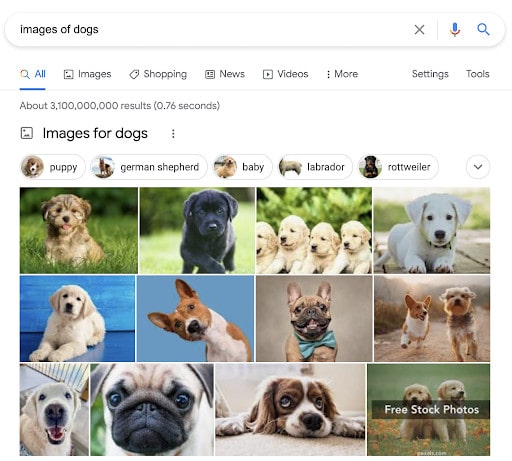
To show up in an image pack, it’s critical that you use alt text on all your images. Alt text is a piece of text that tells Google what an image is about, like, “5-year-old red dachshund lying down.”
Searches can also return video results, as for the query, “videos of dogs.” Video results can show up when videos are explicitly searched for, but they might also show up if you search for a how-to guide, for example.
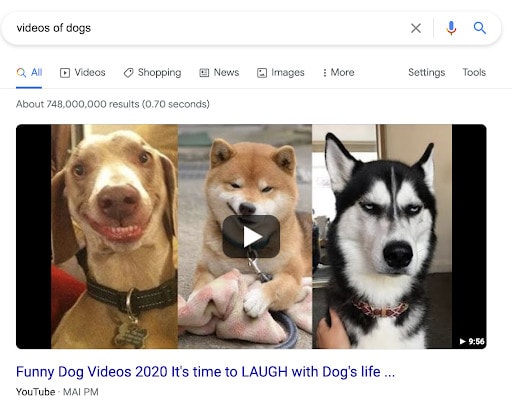
Top stories show up for news results and are often pulled from news sites, but can also be pulled from social media. They often will show up when you input a search related to current events.

Tweet boxes are similar to top stories and show tweets from social media accounts. They generally show up when a brand with an active social media account is searched for.
Sitelinks are links to other pages on a website that appear below the top result. They usually show up when a brand or website is searched for.
How to get onto SERPs
To rank on SERPs, you need to improve your website in three key areas — on-page SEO, off-page SEO, and technical SEO.
On-page SEO
On-page SEO is all about satisfying search intent, which refers to delivering exactly what the searcher intends to find. You do this in a number of ways.
First, you do keyword research using keyword tools, which help you find the keyword phrases that people are using to find information related to your business. Keywords are integral to matching search intent they are what searchers type into the search bar.
For example, when someone searches “smart TVs,” they are likely looking to shop for smart TVs to buy. If someone searches “best smart TVs,” they are likely doing research on smart TVs and are not yet ready to buy.
Each of these keywords would require a different kind of content to rank for. Top-ranking content for “smart TVs” is likely a product page, while top-ranking content for “best smart TVs” is likely an article with reviews and rankings.
Then, you study the SERPs and see what kind of content is ranking for the keyword phrases you’ve chosen. This helps you decide what kind of content to create.
Finally, you create that content and make it as high-quality as possible. What high-quality means in practice is different for every type of content. For example, for the query, “how to invest in Bitcoin,” the top organic result is an article.

High-quality content in this case would likely be a longer listicle (if written content is what you’re trying to rank). It would go more in-depth than the top article, which you would study to try to create content that’s even higher quality.
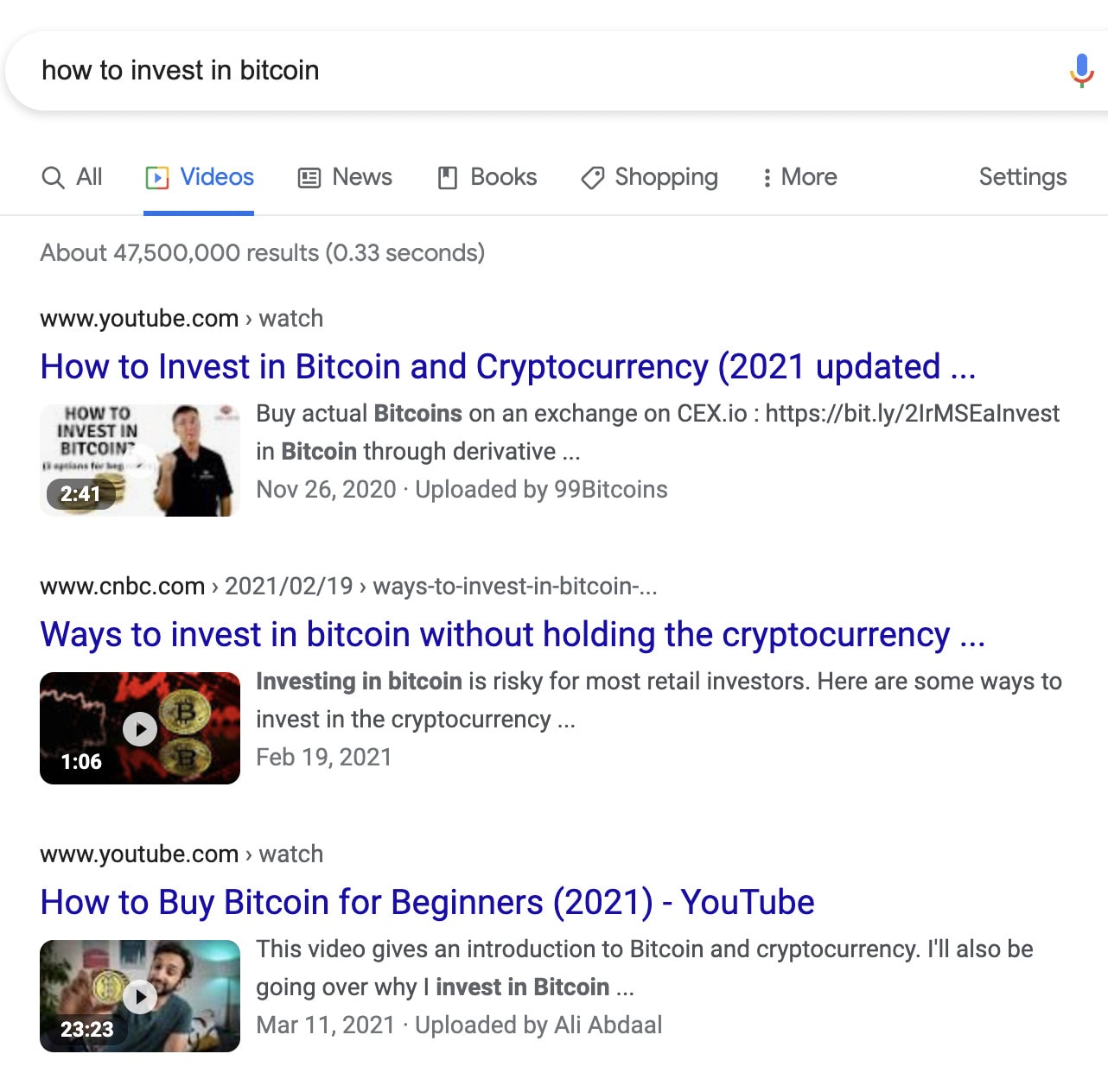
For the video results, high quality might mean something different. One important commonality of the top results is freshness—several of the top videos are for 2021.
Essentially, high quality means does it satisfy search intent by giving searchers what they’re looking for? Sometimes that is a long guide, and other times it is a short definition, but no matter what, top-ranking content is thoughtful, original, easy to consume, and comprehensive.
Off-page SEO
Off-page SEO refers to what is done off of your website to give your website more authority. This essentially means generating backlinks, which are links to your website from other websites.
Google uses backlinks to decide how authoritative your content is by evaluating the authority of the web page that links back to yours. The more authoritative the website that’s linking to you, the more authoritative Google sees your content as.
Quantity of backlinks and quality of backlinks matter, and while there are a number of backlink generation strategies that you can follow, the main way to generate backlinks is to create high-quality content. High-quality content naturally attracts backlinks.
Outside of that, there are other specific link-building strategies you can use to attract links back to your site. You can use social media to promote your content and improve the likelihood someone reads and links to it, you can guest post on other sites, get listed on directories, and even offer to replace broken links.
Technical SEO
Technical SEO refers to the mechanics of your website and mostly has to do with making your website as crawlable and user-friendly as possible by improving site infrastructure. There are several things you can do to give your website a better chance of ranking with technical SEO.
First, you want your website to load quickly. This is important because searchers will abandon your website if it loads too slowly. In fact, your bounce rate increases drastically for every second it takes your website to load.
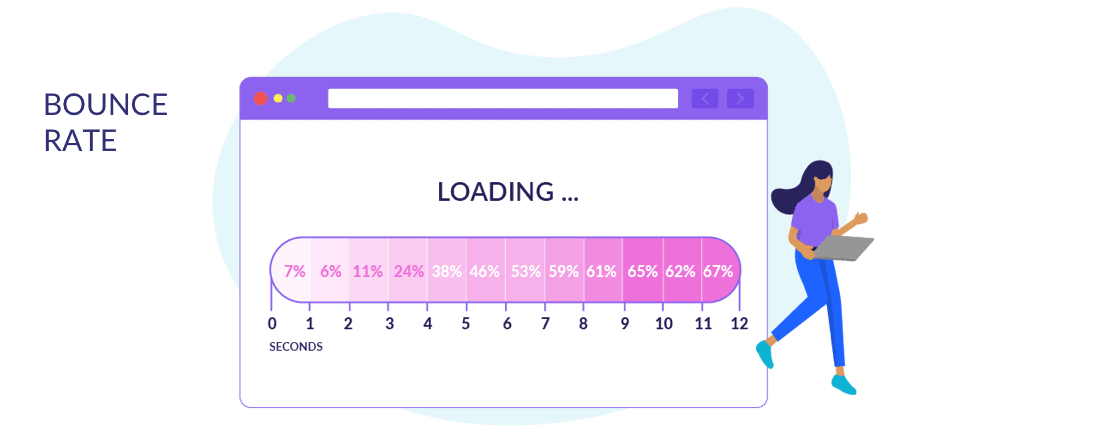
Second, your website needs to be mobile responsive. This means that it displays correctly at all screen sizes and it is easy to use across devices.
Third, you need to have HTTPS enabled. Google wants all websites to use HTTPS to maintain the security of searchers.
Fourth, you want to make your website easy to navigate for both users and crawlers. This means implementing a simple site structure with easy-to-understand menus, category pages, breadcrumbs, and other features that help users to find the content they’re looking for.
This includes internal links, which crawlers use to discover new pages on your website and to understand how pages are related to each other. Internal links also help users to find more content related to the content they’re reading, thus creating a better user experience.
Finally, you want to use schema markup on your website. Schema not only makes it more likely that you can earn rich snippets, but it also helps your content have a better chance of ranking quickly because it tells search engines exactly what your content is so that they don’t have to try to figure it out themselves.
Get a complimentary SEO audit
To generate revenue through your SEO efforts, you need to study SERPs. They tell you what’s ranking and give you insights into why it might be ranking. You can use these insights to create content that has a better chance to rank than it might otherwise, giving you a better chance of generating traffic that can ultimately lead to revenue.
Want to see how you’re doing with SEO? Get an instant SEO audit below. Or, schedule a free consultation to see how intent SEO can boost search traffic revenue by 700%.
